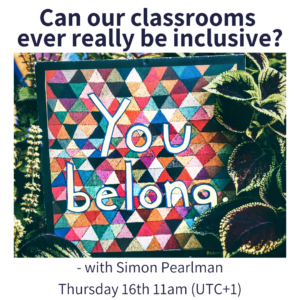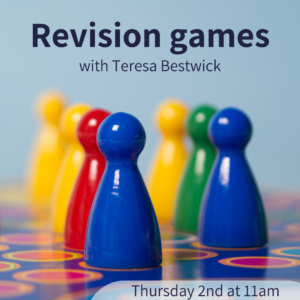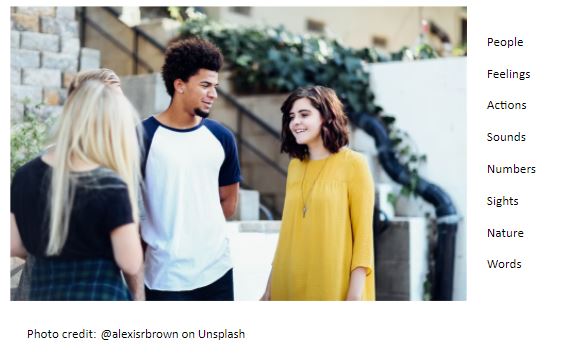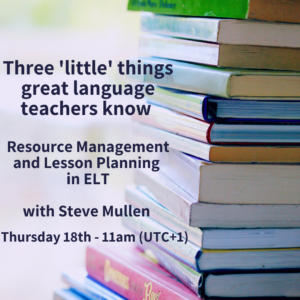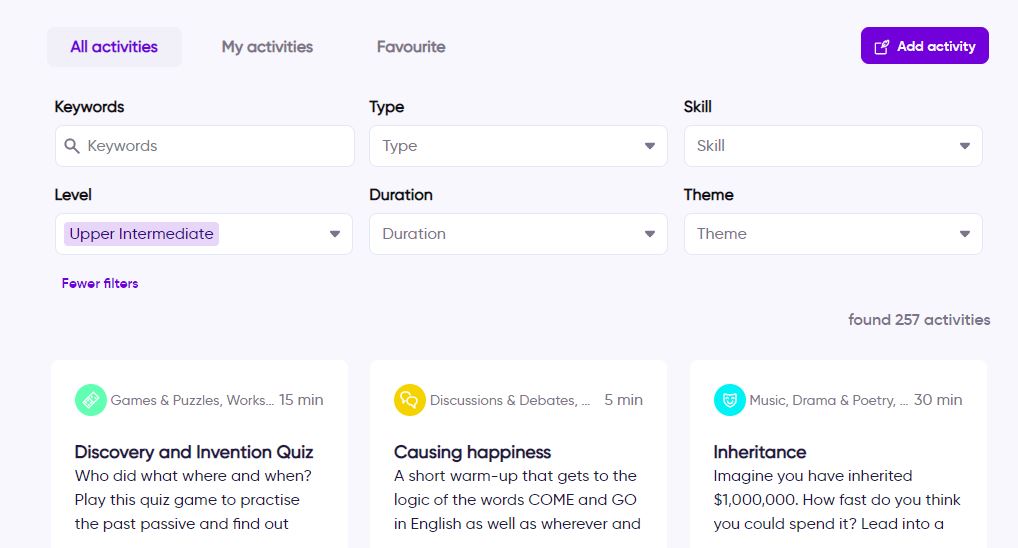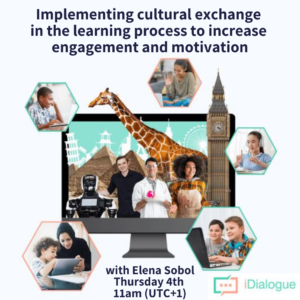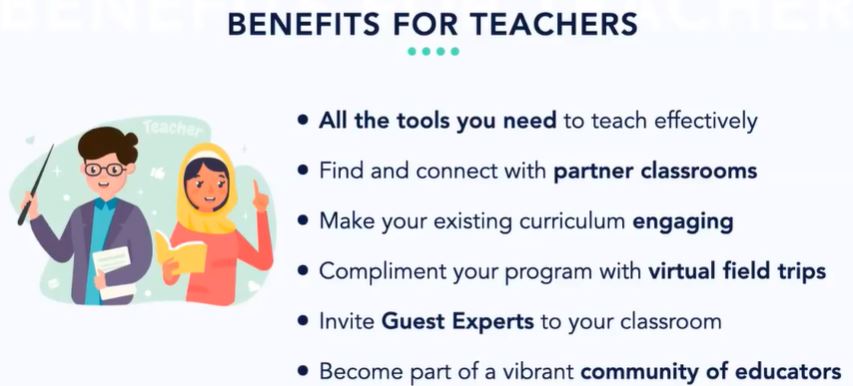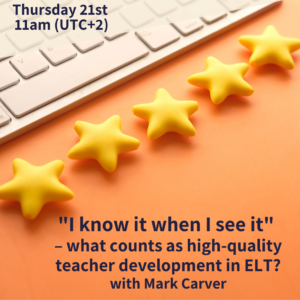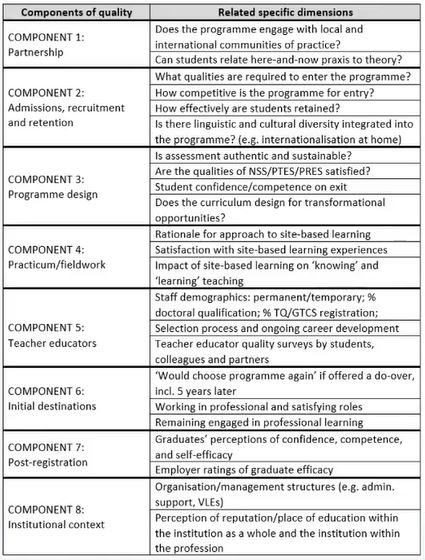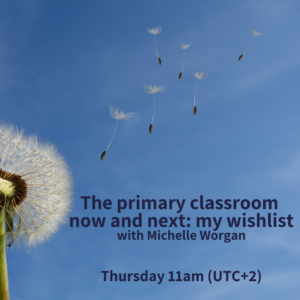Simon Pearlman, co-founder of the Hub, joined us this morning to lead a discussion on the topic of inclusivity in the classroom. He started by highlighting five areas the conversation might look at:
- the issue of inclusivity in general
- the conversations we can have and must continue to have: where to have them, how to have them and how to keep the topic on people’s radars
- the classroom and how we can help everyone feel included and represented
- implementing change on a broader level, for example on teaching training courses and sharing good practice between ourselves
- on levels beyond the classroom – with schools, exams, publishers
Bhavna kicked off the conversation by mentioning a conversation she had a few years ago about the fact that she always referred to teachers as ‘she’ and how that made her more aware of the language she uses. This was a topic which Bhavna talked about later as well with words like master bedroom and mentioned we can introduce our students to a wider range of language everyday (check out for example nibling and pibling as some other gender-neutral family terms). Gender is an interesting topic within ELT and within education in general and this led on to Simon asking what other things we might have on out radar. Catherine mentioned fixed expressions which may have been a staple of the English language for many years but the original meaning of which may have links to slavery, gender stereotypes or other things. Lisa went on to talk about the importance of raising our own awareness in order to deal with these issues and mentioned a similar comment to Bhavna’s: she noticed that she assumes the author of any text in a coursebook is male and uses male pronouns as a default, even though the text could just have likely been written by a woman.
Simon mentioned a book worth reading What White People Can Do Next as a way of recognising, acknowledging and moving on from some of our in-built prejudices. The word feminism also came up and Bhavna raised an interesting point that this can sometimes be seen as an attack on men, when rather humanism would be a better term to use.
Is the classroom the place for these conversations to happen with students and trainee teachers?
Some teachers are becoming somewhat aware of these topic but we might assume they will learn this on their own and Bhavna highlighted teachers need more support. Teachers need to be trained and taught how to foster inclusivity in their own classes. She went on to suggest that working with the students, inclusivity should be integrated, but in training it should be more explicit and include stand-alone sessions on incorporating inclusivity into their own lessons. Catherine said she felt there could be more done on pre-service qualifications as although she is now more aware of these topics, it hasn’t been an explicit focus on recent courses she’s worked on. However, she’s noticed that when she makes conscientious changes – such as changing an image from a coursebook to something more inclusive – it encourages the trainee teachers to do the same. If you’re looking for royalty-free photos to include, Francesca shared this handy list in the chat. Another suggestion to raise awareness was to include a box on lesson plan proformas to focus on inclusivity.
Simon went on to talk about recent experiences of talking to the mainstream schools he works in, which tend to be religious (Catholic). He said they’d had positive responses from the schools about introducing more diverse family models into the materials, both around the idea of divorce, single-parent families and families with single-sex parents. He said that it can sometimes be easy to assume certain people will react in a certain way to some topics, when in fact they were equally interested in reflecting the reality of their students in the materials they use. Lisa talked a little later about the importance of understanding how to have conversations with people who may feel their opinions are being questioned and the importance of not negating another person’s experiences or beliefs.
Who we are thinking of when we talk about inclusivity in education?
This was an interesting question in the chat from Dan. We had touched on some topics (gender, sexuality, face setups) and he suggested another couple: race and disability. T mentioned including a range of narratives in materials, rather than portraying English as a language spoken only by Brits and Americans we should be incorporating stories from other countries and cultures. Claire had a similar case with some materials she was working on for Scandinavia and had been sent pictures of tall, blonde-haired and blue-eyed people. Bhavna mentioned age as an area of inclusion as well.
Simon talked as well about some other aspects of inclusion within the classroom: the students who are quicker or slower at writing need to feel included; students who enjoy pairwork or prefer to work alone; even the height of our students – if we’re doing a boardrush or similar activity, can all the students write on the board comfortably? A couple of alternatives to slow learners were mentioned: late achievers or methodical learners.
Claire mentioned how inclusivity is a form of differentiation and also about the importance of respect – you’re respecting people’s situations, choices and differences. Simon highlighted how this leads onto a bit of a conundrum: if we respect everybody, where is the line when certain beliefs become unacceptable in the classroom? Lisa talked about playing devil’s advocate in some conversations as a way of opening students’ eyes to other people’s points of view.
Claire said that she has sometimes met some resistance with her students (older, business English students who all tend to come from a similar background) when trying to introduce more diverse opinions into the lesson as they tend to have quite fixed mindsets. Simon highlighted that often during a conversation, it can be difficult for people to have their opinions changed as they don’t want to back down from their standpoint, but that they may go away and reflect on the topic. Lisa said as well that sometimes human responses come from a place of fear – whether a fear of change, or losing a position of privilege.
As Bhavna said, it won’t happen overnight, but is rather a journey on which we will all make mistakes. It’s important for us to be aware of what we’re doing right and what we can still do better. It’s also all an evolution and she said that just as some of the language we used ten years ago isn’t seen as acceptable today, similarly there may well be commonly used phrases which in ten years’ time are unacceptable.
We chatted a little bit about generational changes too, with Claire mentioning how the older generation in her Business English classes were far more reluctant to use a more inclusive (non-religious) out-of-office message than the younger employees. Bhavna talked about reactions in India to recent plans to introduce gender-neutral unifroms in some schools and Lisa talked about how TV programmes have changed a lot and there is a far more diverse range of characters than when she was growing up. This led onto some talk around normalising (or usualising which s sometimes seen as a more appropriate term as what is normal?) diversity, rather than making the diversity an issue. Similarly, the idea of incorporating diversity into our lessons rather than focussing on inclusion as something which needs an explicit focus.
Simon rounded up talking about the challenges of differentiation in the classroom: having an awareness of difference and looking for ways to move forward with those differences. It can be realy tough to manage all the individuals in the class at the same time as trying to get through the material, keeping everyone on track, dealing with classroom management and so on. Claire highlighted the importance of learner choice (check out her webinar on the topic here) and how it can allow for a lot of differentiation to happen in the classroom.
Catherine said that at a very basic level, we want people to be comfortable and there may be times when people are on the periphery but then next lesson we might be able to involve them in different ways. Bhavna mentioned as well that at times we do things with the most innocent of intentions and that’s where training can help raise teachers’ awareness of how their actions might make people feel uncomfortable in the lesson. Lisa added that we can do a lot as teachers to demonstrate different strategies to deal with people which our students will then hopefully mimic.
We had a final quick chat around the challenges of coursebooks as Dan wrote in the chat that he had sometimes been asked by publishers not to focus on ‘ugly’ topics such as inequality, unemployment and poverty. T mentioned that it can be challenging as an author to know where your materials will end up and the sort of support the teachers using them will have, whether they’ll be able to deal effectively with any questions which come up and what might trigger students.
